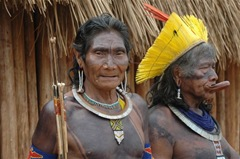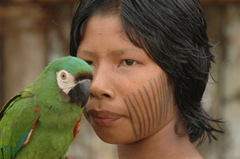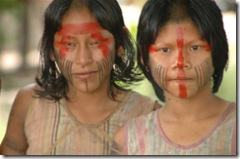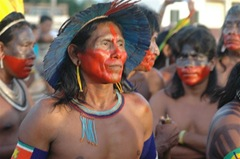 Will this mad and mindless destruction ever stop? From 3000 feet, my view out of the old Cessna’s scratched and scarred windows was depressingly clear — the stripped landscape below was a devastating sight. Knowing that only a few years ago it had been Southern Amazon rainforest, one of the most diverse ecosystems in the world that supported the global human community with a full range of services and a miraculous productivity, I felt unexpected tears running down my cheeks.
Will this mad and mindless destruction ever stop? From 3000 feet, my view out of the old Cessna’s scratched and scarred windows was depressingly clear — the stripped landscape below was a devastating sight. Knowing that only a few years ago it had been Southern Amazon rainforest, one of the most diverse ecosystems in the world that supported the global human community with a full range of services and a miraculous productivity, I felt unexpected tears running down my cheeks.
The Amazon story continues to be in our face. . .but not enough, apparently. I gave my first public presentation about rainforest destruction in 1978, in Australia. And here it is, 28 years later, and below me are the monocrop regimes of cattle and soybeans where there was rainforest just 5 years ago.
The future of the Amazon, Central Africa, and other rainforests around the world is still severely endangered. Large parks and wilderness areas declared by governments are important, but “paper parks” are useless. Education and public awareness are important tools, however, active defense is the bottom line against poverty, greed and power politics. Clearly, the future of large areas of rainforest depends on people who will defend it because their lives depend on it. The Kayapo are doing just that.
 Four of us — two from Conservation International, two from WILD — are headed to a gathering of Kayapo chiefs in the village of Piara’u, in the southern Amazon. For 15 years, CI has funded the Kayapo fight to save their lands — boats, watchtowers, radios, fuel. It’s expensive to patrol and defend the borders of 28 million acres (11 million ha) of tropical rainforest. But they must, because without constant surveillance and action, the ranchers, campesinos, and farmers will eat through their forest like termites in a log. And if the forest goes, so do they. They know it, and they are not going to let it happen.
Four of us — two from Conservation International, two from WILD — are headed to a gathering of Kayapo chiefs in the village of Piara’u, in the southern Amazon. For 15 years, CI has funded the Kayapo fight to save their lands — boats, watchtowers, radios, fuel. It’s expensive to patrol and defend the borders of 28 million acres (11 million ha) of tropical rainforest. But they must, because without constant surveillance and action, the ranchers, campesinos, and farmers will eat through their forest like termites in a log. And if the forest goes, so do they. They know it, and they are not going to let it happen.
Three Kayapo came to the 8th World Wilderness Congress in Alaska (October 2005) to present their story at the first Native Lands and Wilderness Council that convened as part of the 8thWWC. The experience so energized Megaron Txukarram’e, one of the local chiefs, that he returned to his people “a warrior” (as one person described it), bent on uniting his people (21 villages) to meet the escalating threats against them. He did that, and they recognized him as the Head Chief. This meeting at Piara’u is the result, the first time they met as a united nation.
 By all accounts, the Kayapo are an unusual people. They currently number approximately 6,000, with their population having increased 300% over the last 20 years due to enhanced health care. Certainly, out of all my experience around the world with indigenous groups, they are without a doubt the most direct, responsive, and culturally intact indigenous groups. Interestingly, they address you directly, point at you, and they also listen very carefully. They have integrity, honor, and they respect their enemy.
By all accounts, the Kayapo are an unusual people. They currently number approximately 6,000, with their population having increased 300% over the last 20 years due to enhanced health care. Certainly, out of all my experience around the world with indigenous groups, they are without a doubt the most direct, responsive, and culturally intact indigenous groups. Interestingly, they address you directly, point at you, and they also listen very carefully. They have integrity, honor, and they respect their enemy.
Women play a major role. The young wife lives with her matrilineal grandmother, and the new husband joins her house. Terry Turner, the legendary anthropologist who knows them better than anyone, cites this custom, along with their defense of the environment, as the two reasons their culture has remained as intact as it has.
 The Kayapo have a fierce and difficult struggle ahead of them. But it is clear cut — failure means cultural destruction. It is awful, yet awesome, because the stakes are clear, the fight is defined. In our developed cultures we are insulated from the threats, from the food supply, etc -death and destruction are incremental and piecemeal, through pervasive toxicity, habitat degradation, climate change, and the like. If we are going to save this earth, we need some of the frontier mentality. . .we need to fight with honor, but we need to fight.
The Kayapo have a fierce and difficult struggle ahead of them. But it is clear cut — failure means cultural destruction. It is awful, yet awesome, because the stakes are clear, the fight is defined. In our developed cultures we are insulated from the threats, from the food supply, etc -death and destruction are incremental and piecemeal, through pervasive toxicity, habitat degradation, climate change, and the like. If we are going to save this earth, we need some of the frontier mentality. . .we need to fight with honor, but we need to fight.

I am currently sudying the Kayapo tribe in geography, it have found this site very intressting and usefull
Save the Kayapo indians!
I studdied the kayapo indians in high school,,I was the only one in my class and could only find one doco baack them,, to see what the worlds done in twenty yrs is heart breaking..Rescue the forest and its people
Save the Kayapo Indians.
Stop any Dams beingbuilt.
This is my protest!!
SAVE KAYAPO INDIANS!!!!! SAVE KAYAPO!!!
I know what they feeling, my ancestral lands and our elders were being removed, a dam was built in from of our home, military training center behind our back door, and hanford nuclear reservation- 10 miles down the road. It was a sad story my grandmother never let me forget. We had to adapt to the change of life. My prayers to the Kayapo tribe.
I recently read on Facebook that 40,000 Kayapo will be forced to relocate due to a heydro electric plant being buit that will flood their land? Is this true? If so, Is there any way the rest of the world can help to stop it???
Robyn, there are petitions going around to help the Kayapo, including this one we just recently became aware of. Spread the news of what is happening to the Kayapo so that people know what is going on!
This is a common trend in the developing world were the country colonizes its own people. Here in India, the government is fighting its own indegenious people for the sake of mining corportations. This apparently is the ugly truth of capitalism.